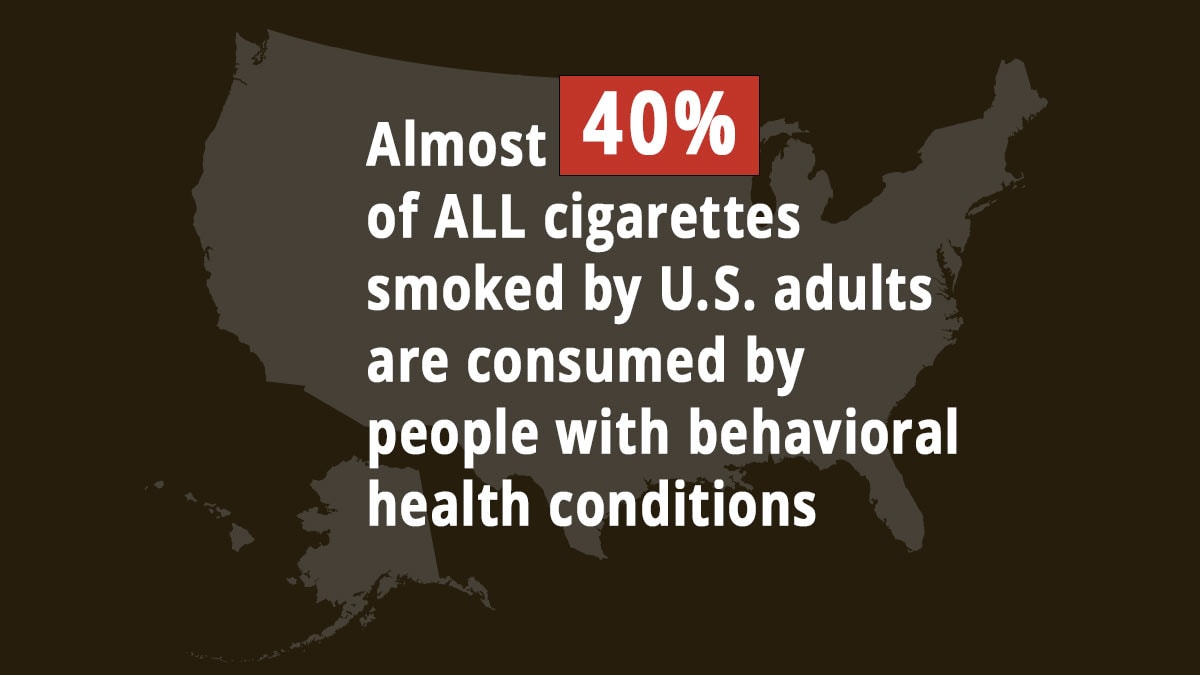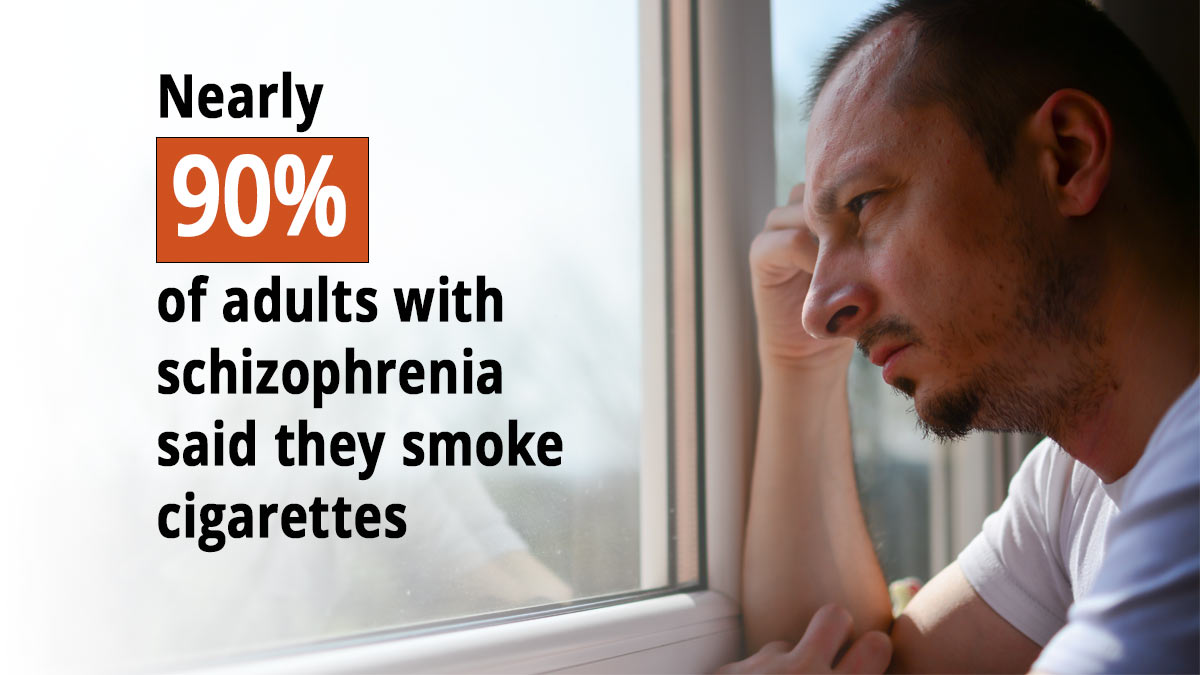At a glance
- Almost 40% of all cigarettes smoked by U.S. adults are consumed by people with behavioral health conditions.
- The most common causes of death among people with behavioral health conditions are heart disease, cancer, and lung disease, which can all be caused by smoking.

Overview
Commercial tobacco prevents achieving health equity for people with behavioral health conditions.A1 For example:
- In 2019, 27.2% of adults with a mental health condition reported smoking cigarettes in the past month—compared to 15.8% of adults with no mental health condition.2
- The most common causes of death among people with behavioral health conditions are heart disease, cancer, and lung disease, which can all be caused by smoking.345
- People with mental health conditions who smoke cigarettes have two times the risk of premature death than people with behavioral health conditions who do not smoke.6
- People with behavioral health conditions are targets of aggressive commercial tobacco marketing.78
- People with behavioral health conditions may not be protected from secondhand smoke when seeking services in behavioral health treatment settings. Only about half of mental health treatment centers and one-third of substance use disorder treatment centers report having a smokefree campus.9 There is no safe level of exposure to secondhand smoke.

- People with certain diagnoses, such as depression and anxiety, or people with substance use disorders (other than tobacco use disorder) are more likely to use commercial tobacco than those without these disorders.10111213 For example, nearly 90% of adults with schizophrenia reported smoking cigarettes in a 2006 survey.14

Content Source:
National Center for Chronic Disease Prevention and Health Promotion; Office on Smoking and Health
- "Commercial tobacco" means harmful products that are made and sold by tobacco companies. It does not include "traditional tobacco" used by Indigenous groups for religious or ceremonial purposes.
- Substance Abuse and Mental Health Services Administration. Results from the 2016 National Survey on Drug Use and Health: Detailed Tables. Substance Abuse and Mental Health Services Administration, Center for Behavioral Health Statistics and Quality; 2017. Accessed Feb 25, 2022. https://www.samhsa.gov/data/report/results-2016-national-survey-drug-use-and-health-detailed-tables.
- Center for Behavioral Health Statistics and Quality. Results from the 2019 National Survey on Drug Use and Health: Detailed Tables. Substance Abuse and Mental Health Services Administration; 2020. Accessed Feb 25, 2022. https://www.samhsa.gov/data/report/2019-nsduh-detailed-tables
- Druss BG, Zhao L, Von Esenwein S, Morrato EH, Marcus SC. Understanding Excess Mortality in Persons With Mental Illness: 17-Year Follow Up of a Nationally Representative US Survey. Med Care. 2011;49(6):599–604. DOI: 10.1097/MLR.0b013e31820bf86e
- Schroeder S A, Morris CD. Confronting a Neglected Epidemic: Tobacco Cessation for Persons With Mental Illnesses and Substance Abuse Problems. Annual Review of Public Health. 2010;31:297–314. DOI: https://doi.org/10.1146/annurev.publhealth.012809.103701
- Richter KP, Arnsten JH. A Rationale and Model for Addressing Tobacco Dependence in Substance Abuse Treatment. Subst Abuse Treat Prev Policy. 2006;1(1):23. DOI: https://doi.org/10.1186/1747-597X-1-23.
- Tam J, Warner KE, Meza R. Smoking and the Reduced Life Expectancy of Individuals With Serious Mental Illness. Am J Prev Med. 2016; 51(6):958–966. DOI: 10.1016/j.amepre.2016.06.007.
- Apollonio DE, Malone RE. Marketing to the Marginalised: Tobacco Industry Targeting of the Homeless and Mentally Ill. Tob Control. 2005;14(6):409-415. DOI: 10.1136/tc.2005.011890.
- Campbell BK, Le T, Andrews KB, Pramod S, Guydish J. Smoking Among Patients in Substance Use Disorders Treatment: Associations With Tobacco Advertising, Anti-Tobacco Messages, and Perceived Health Risks. Am J Drug Alcohol Abuse. 2016;42(6):649-656. DOI: 10.1080/00952990.2016.1183021.
- Marynak K, Vanfrank B, Tetlow S, Mahoney M, Phillips E, Jamal A, et al. Tobacco Cessation Interventions and Smoke-Free Policies in Mental Health and Substance Abuse Treatment Facilities—United States, 2016. MMWR Morb Mortal Wkly Rep. 2018;67(18):519-23. DOI: http://dx.doi.org/10.15585/mmwr.mm6718a3.
- Jamal A, Phillips E, Gentzke AS, Homa DM, Babb SD, King BA, et al. Current Cigarette Smoking Among Adults - United States, 2016. MMWR Morb Mortal Wkly Rep. 2018;67(2):53-59. DOI: http://dx.doi.org/10.15585/mmwr.mm6702a1.
- Cook BL, Wayne GF, Kafali EN, Liu Z, Shu C, Flores M. Trends in Smoking Among Adults With Mental Illness and Association Between Mental Health Treatment and Smoking Cessation. JAMA. 2014;311(2):172–182. DOI: 10.1001/jama.2013.284985.
- Dickerson F, Schroeder J, Katsafanas E, Khushalani S, Origoni AE, Savage C, et al. Cigarette Smoking by Patients With Serious Mental Illness, 1999-2016: An Increasing Disparity. Psychiatr Serv. 2018;69(2):147-153. DOI: 10.1176/appi.ps.201700118.
- Young-Wolff KC, Hickman NJ 3rd, Kim R, Gali K, Prochaska JJ. Correlates and Prevalence of Menthol Cigarette Use Among Adults With Serious Mental Illness. Nicotine Tob Res. 2015;17(3):285-291. DOI: 10.1093/ntr/ntu141.
- NIH State-of-the-Science Panel. National Institutes of Health State-of-the-Science Conference Statement: Tobacco Use: Prevention, Cessation, and Control. Ann Intern Med. 2006;145:839-844. DOI: 10.7326/0003-4819-145-11-200612050-00141
